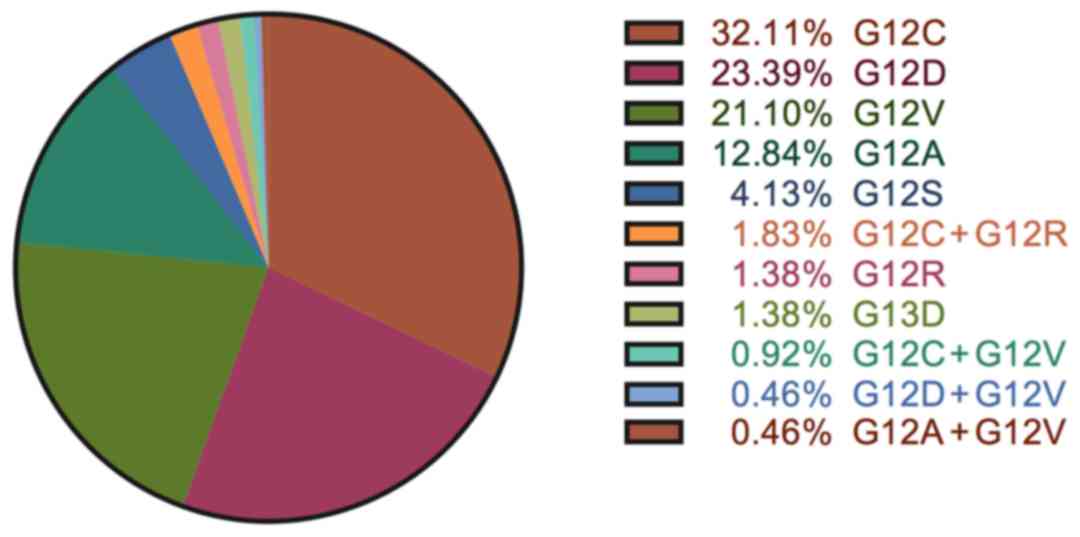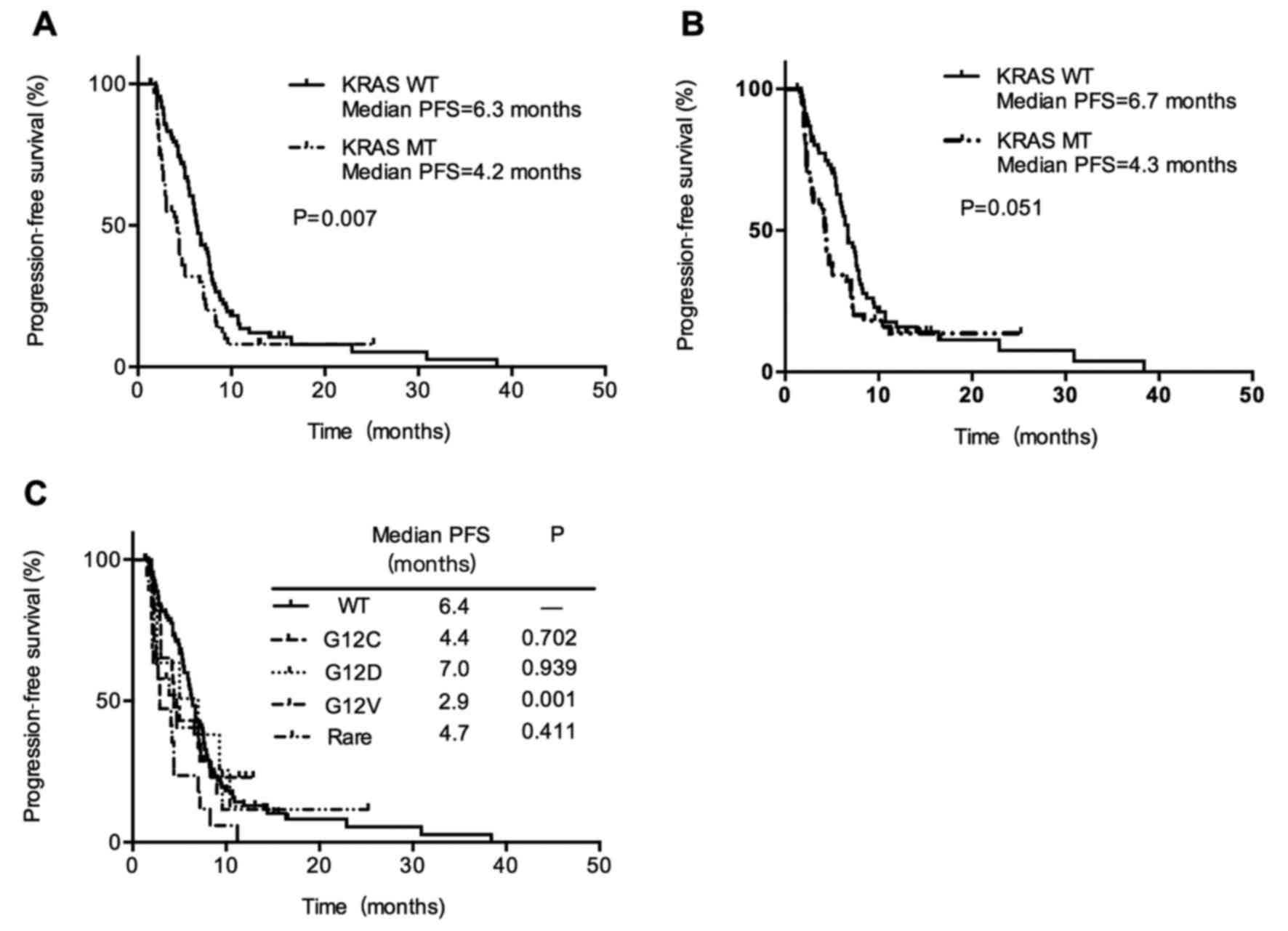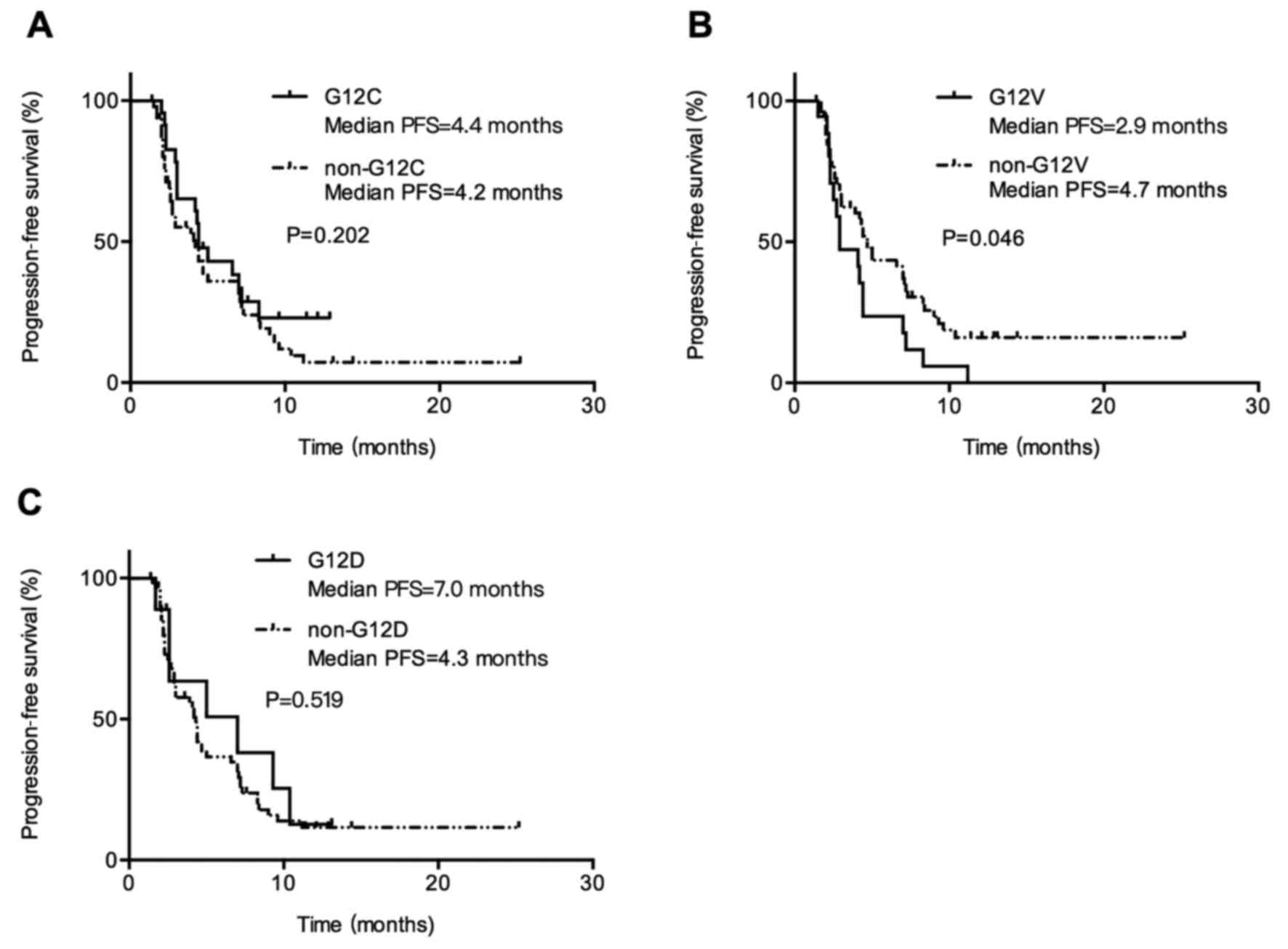|
1
|
Torre LA, Bray F, Siegel RL, Ferlay J,
Lortet-Tieulent J and Jemal A: Global cancer statistics, 2012. CA
Cancer J Clin. 65:87–108. 2015. View Article : Google Scholar : PubMed/NCBI
|
|
2
|
Chen W, Zheng R, Baade PD, Zhang S, Zeng
H, Bray F, Jemal A, Yu XQ and He J: Cancer statistics in China,
2015. CA Cancer J Clin. 66:115–132. 2016. View Article : Google Scholar : PubMed/NCBI
|
|
3
|
Chen Z, Fillmore CM, Hammerman PS, Kim CF
and Wong KK: Non-small-cell lung cancers: A heterogeneous set of
diseases. Nat Rev Cancer. 14:535–546. 2014. View Article : Google Scholar : PubMed/NCBI
|
|
4
|
Zhou C, Wu YL, Chen G, Feng J, Liu XQ,
Wang C, Zhang S, Wang J, Zhou S, Ren S, et al: Erlotinib versus
chemotherapy as first-line treatment for patients with advanced
EGFR mutation-positive non-small-cell lung cancer (OPTIMAL,
CTONG-0802): A multicentre, open-label, randomised, phase 3 study.
Lancet Oncol. 12:735–742. 2011. View Article : Google Scholar : PubMed/NCBI
|
|
5
|
Miyanaga A, Shimizu K, Noro R, Seike M,
Kitamura K, Kosaihira S, Minegishi Y, Shukuya T, Yoshimura A,
Kawamoto M, et al: Activity of EGFR-tyrosine kinase and ALK
inhibitors for EML4-ALK-rearranged non-small-cell lung cancer
harbored coexisting EGFR mutation. BMC Cancer. 13:2622013.
View Article : Google Scholar : PubMed/NCBI
|
|
6
|
Friboulet L, Li N, Katayama R, Lee CC,
Gainor JF, Crystal AS, Michellys PY, Awad MM, Yanagitani N, Kim S,
et al: The ALK inhibitor ceritinib overcomes crizotinib resistance
in non-small cell lung cancer. Cancer Discov. 4:662–673. 2014.
View Article : Google Scholar : PubMed/NCBI
|
|
7
|
Solomon BJ, Mok T, Kim DW, Wu YL, Nakagawa
K, Mekhail T, Felip E, Cappuzzo F, Paolini J, Usari T, et al:
First-line crizotinib versus chemotherapy in ALK-positive lung
cancer. N Engl J Med. 371:2167–2177. 2014. View Article : Google Scholar : PubMed/NCBI
|
|
8
|
Riely GJ, Marks J and Pao W: KRAS
mutations in non-small cell lung cancer. Proc Am Thorac Soc. 6:pp.
201–205. 2009, View Article : Google Scholar : PubMed/NCBI
|
|
9
|
Piva S, Ganzinelli M, Garassino MC, Caiola
E, Farina G, Broggini M and Marabese M: Across the universe of
K-RAS mutations in non-small-cell-lung cancer. Curr Pharm Des.
20:3933–3943. 2014. View Article : Google Scholar : PubMed/NCBI
|
|
10
|
Xia N, An J, Jiang QQ, Li M, Tan J and Hu
CP: Analysis of EGFR, EML4-ALK, KRAS, and c-MET mutations in
Chinese lung adenocarcinoma patients. Exp Lung Res. 39:328–335.
2013. View Article : Google Scholar : PubMed/NCBI
|
|
11
|
Gao B, Sun Y, Zhang J, Ren Y, Fang R, Han
X, Shen L, Liu XY, Pao W, Chen H and Ji H: Spectrum of LKB1, EGFR,
and KRAS mutations in chinese lung adenocarcinomas. J Thorac Oncol.
5:1130–1135. 2010. View Article : Google Scholar : PubMed/NCBI
|
|
12
|
Malumbres M and Barbacid M: RAS oncogenes:
The first 30 years. Nat Rev Cancer. 3:459–465. 2003. View Article : Google Scholar : PubMed/NCBI
|
|
13
|
Pylayeva-Gupta Y, Grabocka E and Bar-Sagi
D: RAS oncogenes: Weaving a tumorigenic web. Nat Rev Cancer.
11:761–774. 2011. View Article : Google Scholar : PubMed/NCBI
|
|
14
|
Brady AK, McNeill JD, Judy B, Bauml J,
Evans TL, Cohen RB, Langer C, Vachani A and Aggarwal C: Survival
outcome according to KRAS mutation status in newly diagnosed
patients with stage IV non-small cell lung cancer treated with
platinum doublet chemotherapy. Oncotarget. 6:30287–30294. 2015.
View Article : Google Scholar : PubMed/NCBI
|
|
15
|
Garassino MC, Marabese M, Rusconi P, Rulli
E, Martelli O, Farina G, Scanni A and Broggini M: Different types
of K-Ras mutations could affect drug sensitivity and tumour
behaviour in non-small-cell lung cancer. Ann Oncol. 22:235–237.
2011. View Article : Google Scholar : PubMed/NCBI
|
|
16
|
Ihle NT, Byers LA, Kim ES, Saintigny P,
Lee JJ, Blumenschein GR, Tsao A, Liu S, Larsen JE, Wang J, et al:
Effect of KRAS oncogene substitutions on protein behavior:
Implications for signaling and clinical outcome. J Natl Cancer
Inst. 104:228–239. 2012. View Article : Google Scholar : PubMed/NCBI
|
|
17
|
Miller MS and Miller LD: RAS mutations and
oncogenesis: Not all RAS mutations are created equally. Front
Genet. 2:1002012. View Article : Google Scholar : PubMed/NCBI
|
|
18
|
Slebos RJ, Kibbelaar RE, Dalesio O,
Kooistra A, Stam J, Meijer CJ, Wagenaar SS, Vanderschueren RG, van
Zandwijk N, Mooi WJ, et al: K-ras oncogene activation as a
prognostic marker in adenocarcinoma of the lung. N Engl J Med.
323:561–565. 1990. View Article : Google Scholar : PubMed/NCBI
|
|
19
|
Mellema WW, Dingemans AM, Thunnissen E,
Snijders PJ, Derks J, Heideman DA, Van Suylen R and Smit EF: KRAS
mutations in advanced nonsquamous non-small-cell lung cancer
patients treated with first-line platinum-based chemotherapy have
no predictive value. J Thorac Oncol. 8:1190–1195. 2013. View Article : Google Scholar : PubMed/NCBI
|
|
20
|
Rulli E, Marabese M, Torri V, Farina G,
Veronese S, Bettini A, Longo F, Moscetti L, Ganzinelli M,
Lauricella C, et al: Value of KRAS as prognostic or predictive
marker in NSCLC: Results from the TAILOR trial. Ann Oncol.
26:2079–2084. 2015. View Article : Google Scholar : PubMed/NCBI
|
|
21
|
Hames ML, Chen H, Iams W, Aston J, Lovly
CM and Horn L: Correlation between KRAS mutation status and
response to chemotherapy in patients with advanced non-small cell
lung cancer. Lung Cancer. 92:29–34. 2016. View Article : Google Scholar : PubMed/NCBI
|
|
22
|
Campos-Parra AD, Zuloaga C, Manriquez ME,
Avilés A, Borbolla-Escoboza J, Cardona A, Meneses A and Arrieta O:
KRAS mutation as the biomarker of response to chemotherapy and
EGFR-TKIs in patients with advanced non-small cell lung cancer:
Clues for its potential use in second-line therapy decision making.
Am J Clin Oncol. 38:33–40. 2015. View Article : Google Scholar : PubMed/NCBI
|
|
23
|
Metro G, Chiari R, Bennati C, Cenci M,
Ricciuti B, Puma F, Flacco A, Rebonato A, Giannarelli D, Ludovini
V, et al: Clinical outcome with platinum-based chemotherapy in
patients with advanced nonsquamous EGFR wild-type non-small-cell
lung cancer segregated according to KRAS mutation status. Clin Lung
Cancer. 15:86–92. 2014. View Article : Google Scholar : PubMed/NCBI
|
|
24
|
Marabese M, Ganzinelli M, Garassino MC,
Shepherd FA, Piva S, Caiola E, Macerelli M, Bettini A, Lauricella
C, Floriani I, et al: KRAS mutations affect prognosis of
non-small-cell lung cancer patients treated with first-line
platinum containing chemotherapy. Oncotarget. 6:34014–34022. 2015.
View Article : Google Scholar : PubMed/NCBI
|
|
25
|
Sobin LH, Gospodarowicz MK and Wittekind
C: TNM Classification of Malignant Tumors. 7th edition.
Wiley-Blackwell; New York: 2009
|
|
26
|
Eisenhauer EA, Therasse P, Bogaerts J,
Schwartz LH, Sargent D, Ford R, Dancey J, Arbuck S, Gwyther S,
Mooney M, et al: New response evaluation criteria in solid tumours:
Revised RECIST guideline (version 1.1). Eur J Cancer. 45:228–247.
2009. View Article : Google Scholar : PubMed/NCBI
|
|
27
|
Deng LL, Deng HB, Lu CL, Guo Y, Wang D,
Yan CH, Lv X and Shao YX: Mutations of EGFR or KRAS and expression
of chemotherapy-related genes based on small biopsy samples in
stage IIIB and IV inoperable non-small cell lung cancer. J Cancer
Res Clin Oncol. 140:2097–2105. 2014. View Article : Google Scholar : PubMed/NCBI
|
|
28
|
Wu C, Zhao C, Yang Y, He Y, Hou L, Li X,
Gao G, Shi J, Ren S, Chu H, et al: High discrepancy of driver
mutations in patients with NSCLC and synchronous multiple lung
ground-glass nodules. J Thorac Oncol. 10:778–783. 2015. View Article : Google Scholar : PubMed/NCBI
|
|
29
|
Ren S, Kuang P, Zheng L, Su C, Li J, Li B,
Chen X, Wang Y, KimCurran V, Liu L, et al: Analysis of driver
mutations in female non-smoker Asian patients with pulmonary
adenocarcinoma. Cell Biochem Biophys. 64:155–160. 2012. View Article : Google Scholar : PubMed/NCBI
|
|
30
|
Costa DB, Shaw AT, Ou SH, Solomon BJ,
Riely GJ, Ahn MJ, Zhou C, Shreeve SM, Selaru P, Polli A, et al:
Clinical experience with crizotinib in patients with advanced
ALK-rearranged non-small-cell lung cancer and brain metastases. J
Clin Oncol. 33:1881–1888. 2015. View Article : Google Scholar : PubMed/NCBI
|
|
31
|
Wang Z, Wu YL, Zhang GC, Zhou Q, Xu CR and
Guo AL: EGFR/KRAS mutations and gefitinib therapy in Chinese NSCLC
patients. Onkologie. 31:174–178. 2008. View Article : Google Scholar : PubMed/NCBI
|
|
32
|
Li M, Liu L, Liu Z, Yue S, Zhou L, Zhang
Q, Cheng S, Li RW, Smith PN and Lu S: The status of KRAS mutations
in patients with non-small cell lung cancers from mainland China.
Oncol Rep. 22:1013–1020. 2009.PubMed/NCBI
|
|
33
|
Jia XL and Chen G: EGFR and KRAS mutations
in Chinese patients with adenosquamous carcinoma of the lung. Lung
Cancer. 74:396–400. 2011. View Article : Google Scholar : PubMed/NCBI
|
|
34
|
Kim HR, Shim HS, Chung JH, Lee YJ, Hong
YK, Rha SY, Kim SH, Ha SJ, Kim SK, Chung KY, et al: Distinct
clinical features and outcomes in never-smokers with nonsmall cell
lung cancer who harbor EGFR or KRAS mutations or ALK rearrangement.
Cancer. 118:729–739. 2012. View Article : Google Scholar : PubMed/NCBI
|
|
35
|
Sun JM, Hwang DW, Ahn JS, Ahn MJ and Park
K: Prognostic and predictive value of KRAS mutations in advanced
non-small cell lung cancer. PLoS One. 8:e648162013. View Article : Google Scholar : PubMed/NCBI
|
|
36
|
Ahrendt SA, Decker PA, Alawi EA, Zhu YRYR,
Sanchez-Cespedes M, Yang SC, Haasler GB, Kajdacsy-Balla A, Demeure
MJ and Sidransky D: Cigarette smoking is strongly associated with
mutation of the K-ras gene in patients with primary adenocarcinoma
of the lung. Cancer. 92:1525–1530. 2001. View Article : Google Scholar : PubMed/NCBI
|
|
37
|
Riely GJ, Kris MG, Rosenbaum D, Marks J,
Li A, Chitale DA, Nafa K, Riedel ER, Hsu M, Pao W, et al: Frequency
and distinctive spectrum of KRAS mutations in never smokers with
lung adenocarcinoma. Clin Cancer Res. 14:5731–5734. 2008.
View Article : Google Scholar : PubMed/NCBI
|
|
38
|
Imamura Y, Morikawa T, Liao X, Lochhead P,
Kuchiba A, Yamauchi M, Qian ZR, Nishihara R, Meyerhardt JA, Haigis
KM, et al: Specific mutations in KRAS codons 12 and 13, and patient
prognosis in 1075 BRAF wild-type colorectal cancers. Clin Cancer
Res. 18:4753–4763. 2012. View Article : Google Scholar : PubMed/NCBI
|
|
39
|
Shepherd FA, Domerg C, Hainaut P, Jänne
PA, Pignon JP, Graziano S, Douillard JY, Brambilla E, Le Chevalier
T, Seymour L, et al: Pooled analysis of the prognostic and
predictive effects of KRAS mutation status and KRAS mutation
subtype in early-stage resected non-small-cell lung cancer in four
trials of adjuvant chemotherapy. J Clin Oncol. 31:2173–2181. 2013.
View Article : Google Scholar : PubMed/NCBI
|
|
40
|
Cserepes M, Ostoros G, Lohinai Z, Raso E,
Barbai T, Timar J, Rozsas A, Moldvay J, Kovalszky I, Fabian K, et
al: Subtype-specific KRAS mutations in advanced lung
adenocarcinoma: A retrospective study of patients treated with
platinum-based chemotherapy. Eur J Cancer. 50:1819–1828. 2014.
View Article : Google Scholar : PubMed/NCBI
|
|
41
|
Izar B, Zhou H, Heist RS, Azzoli CG,
Muzikansky A, Scribner EE, Bernardo LA, Dias-Santagata D, Iafrate
AJ and Lanuti M: The prognostic impact of KRAS, its codon and amino
acid specific mutations, on survival in resected stage I lung
adenocarcinoma. J Thorac Oncol. 9:1363–1369. 2014. View Article : Google Scholar : PubMed/NCBI
|
|
42
|
Stolze B, Reinhart S, Bulllinger L,
Fröhling S and Scholl C: Comparative analysis of KRAS codon 12, 13,
18, 61, and 117 mutations using human MCF10A isogenic cell lines.
Sci Rep. 5:85352015. View Article : Google Scholar : PubMed/NCBI
|
|
43
|
Thomas RK, Weir B and Meyerson M: Genomic
approaches to lung cancer. Clin Cancer Res. 12:4384s–4391s. 2006.
View Article : Google Scholar : PubMed/NCBI
|
|
44
|
Zhou W and Christiani DC: East meets West:
Ethnic differences in epidemiology and clinical behaviors of lung
cancer between East Asians and Caucasians. Chin J Cancer.
30:287–292. 2011. View Article : Google Scholar : PubMed/NCBI
|













